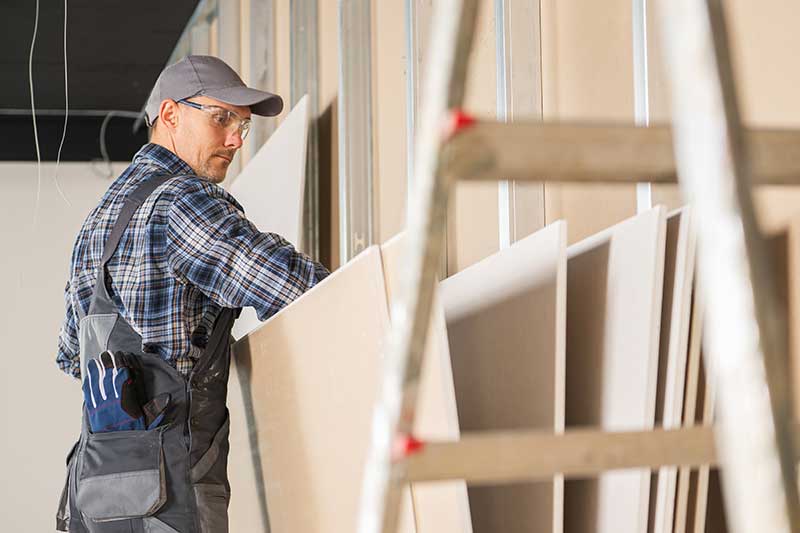
Embarking on a home renovation project can be exciting, but it can also be daunting, especially when you encounter unfamiliar terms like understanding drywall. Drywall is a common building material that forms the interior walls and ceilings in most homes, offices, and other structures. But if you’re new to home improvement, it can be easy to feel lost in a sea of technical jargon.
This beginner’s guide is here to help! We’ll break down everything you need to know about drywall in clear, easy-to-understand language. By the end of this guide, you’ll be able to discuss drywall types, installation processes, and finishing techniques with confidence, feeling empowered to tackle DIY projects or have informed conversations with professional contractors.
What is Drywall?
Drywall, also known as plasterboard or gypsum board, is the workhorse behind the smooth, finished surfaces of your walls and ceilings. Its core is made of gypsum plaster, a naturally occurring mineral that provides several benefits relevant to understanding drywall. Gypsum plaster is fire-resistant, which helps to slow the spread of flames in a fire event.
It’s also a good sound insulator, contributing to a quieter and more peaceful home environment. Sandwiched between two thick paper liners, the gypsum plaster forms a lightweight and easy-to-work-with panel. This makes drywall a popular choice for both professional builders and DIY enthusiasts tackling renovation projects.
Why Drywall is a Top Choice
Drywall is popular for several reasons:
- Ease of Installation: It’s relatively lightweight and easy to cut and install, making it a favorite among builders and DIY enthusiasts.
- Fire Resistance: Gypsum is naturally fire-resistant, adding an extra layer of safety to your home.
- Sound Dampening: Drywall helps reduce noise transfer between rooms, creating a quieter and more peaceful living environment.
- Smooth Finish: Once installed and finished, drywall provides a smooth, even surface that’s perfect for painting or wallpapering.
Common Types of Drywall
- Regular Drywall: This is the standard drywall used in most walls and ceilings.
- Moisture-Resistant Drywall (Green Board): Designed to resist mold and mildew, it’s ideal for bathrooms, basements, and other areas prone to moisture.
- Fire-Resistant Drywall (Type X): This thicker drywall offers increased fire resistance and is often used in garages and near fireplaces.
Drywall Installation: A Step-by-Step Overview
- Measure and Cut: Drywall sheets are measured and cut to fit the specific dimensions of the wall or ceiling.
- Attach: The sheets are then securely screwed or nailed to the wall studs or ceiling joists.
- Tape and Mud: Drywall tape is used to cover the joints between the sheets. Then, joint compound (mud) is layered over the tape to create a seamless surface.
- Sand and Prime: Once the mud dries, it’s sanded smooth and primed, preparing the surface for paint or wallpaper.
Drywall Finishing: The Art of Perfection
Drywall finishing is where the magic happens! Skilled drywall finishers are like artists, transforming rough drywall panels into flawlessly smooth and pristine surfaces. They possess a unique blend of skill, experience, and a keen eye for detail.
Using a variety of specialized tools and techniques, they meticulously apply, smooth, and sand joint compound to conceal seams and imperfections. The result? Walls and ceilings that appear as if they were poured from a single mold, ready to be adorned with paint or wallpaper and become a beautiful backdrop for your living space.
Drywall and Your Home
Understanding drywall is a valuable asset, whether you’re a seasoned DIY enthusiast tackling a complex renovation project or a curious homeowner simply wondering how your house is built. Drywall goes beyond just being a simple material for walls and ceilings.
It plays a significant role in the comfort, safety, and beauty of your home. The fire-resistant properties of drywall contribute to the overall fire safety of your living space. Drywall also acts as a sound barrier, reducing noise transmission between rooms and creating a more peaceful and tranquil atmosphere.
Additionally, properly installed and finished drywall provides a smooth, even surface that forms the foundation for a beautiful and aesthetically pleasing interior.
Whether you dream of painting your walls in a calming shade or showcasing your favorite wallpaper patterns, drywall provides the perfect canvas to bring your design visions to life.
Your Journey to Understanding Drywall Starts Here
Empowered with this foundational knowledge of drywall, you’re ready to delve deeper! In future blog posts, we’ll explore advanced topics like selecting the perfect drywall type for your specific project.
We’ll guide you through the decision-making process, considering factors like moisture resistance, fire safety needs, and soundproofing requirements. Additionally, we’ll equip you with the knowledge to achieve a professional-looking finish on your drywall.
We’ll break down the drywall finishing process step-by-step, providing expert tips and tricks for flawlessly taping, mudding, sanding, and priming your walls. Stay tuned for more drywall expertise to transform your home renovation dreams into reality!
Do you have any questions about drywall? Feel free to ask call us now or contact us
Home Depot Drywall
See Our Drywall Expertise in Action
Are you curious to see the results of professional drywall installation and finishing? We’re proud to showcase our work through a gallery of stunning before-and-after photos. Witness firsthand the transformative power of drywall in creating beautiful, functional spaces.
